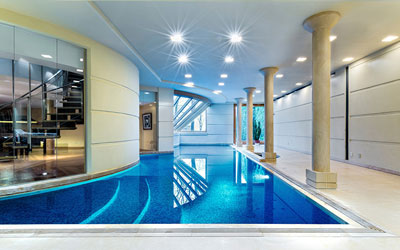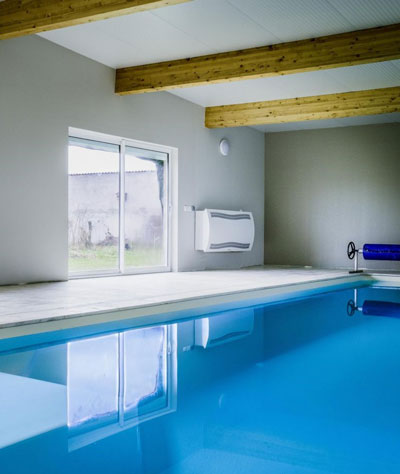The indoor pool is the perfect way to swim all year round. It is a place where the often sought-after decoration has been chosen with care and which gives this space an idyllic and relaxing side. We can't imagine that to achieve this result, it took a lot of thought, analysis, making the right equipment choices...

The indoor swimming pool
From the design to the choice of structure or covering, it is essential to take the time to reflect. The indoor pool involves certain obligations that must be taken into account. The humidity and heat that reign in this enclosed area are special characteristics of the indoor swimming pool. If we can easily imagine the advantages that we can derive from an indoor swimming pool, we must nevertheless not forget that there can also be disadvantages.
Condensation in indoor swimming pool
The success of the indoor or covered swimming pool requires knowledge of the different elements that make this place such a special place. A point that must be taken very seriously into account is condensation in indoor pools which will inevitably be created in the space aquatic. So, to fight against this scourge, it is necessary to know it, to know how and why it is created, what are its effects on the building, the bathers. How to measure the humidity of this room? It is therefore necessary to stop a little and analyze this phenomenon.
How to limit condensation in an indoor swimming pool?
When you know the damage that condensation can do in an aquatic room, it is essential to put in place all possible solutions to stop the damage. To do this, you need to know how to limit condensation in the indoor pool? The insulation of the building and/or the pool room, the ventilation of the premises are means to be implemented to channel this humidity. To keep your swimming pool hall healthy and comfortable, you can install ventilation, a dehumidifier and simple actions can be implemented to limit condensation and "help" equipment to fulfill their mission. But which solution to choose? Are they comparable or complementary?

How does the pool dehumidifier work?
The swimming pool dehumidifier is a simple piece of equipment to operate, but to use it properly, know how does the swimming pool dehumidifier work and the various elements that compose it as well as their role, are undeniable assets for the buyer. The swimming pool dehumidifier has features and options that can be useful and allow you to better target the choice of your device. Is this equipment really necessary? Why and when should it be installed?
What types of pool dehumidifiers?
When you decide to build or create your indoor pool or install a shelter around your outdoor pool, you need a dehumidifier to maintain the humidity level and limit condensation. Yes, but, lo and behold, by studying the “market”, it turns out that a large number of devices are available. So what types of swimming pool dehumidifiers are available and which should you choose? Opt for a dehumidifier or ventilation? A freestanding or fixed dehumidifier? Ductable or recessed? What are their advantages and disadvantages?
How to choose your swimming pool dehumidifier?
To make a successful purchase, you must already know how to choose your pool dehumidifier. First, identify the needs of the pool room and define the amount of humidity to be evacuated. The heat balance is an essential aid for choosing the dehumidifier. Other elements such as energy consumption, noise level or special options can also be criteria for selecting the dehumidifier that best suits the characteristics of the aquatic room.
Successful installation of your swimming pool dehumidifier
Generally, it is necessary to call on a professional for the installation of a built-in or ducted dehumidifier. But successfully installing your pool dehumidifier is easier. It can be installed by yourself, respecting the instructions and having the required skills, particularly in electricity. The use of this device is simple and easy, as is its maintenance. Regular cleaning is essential for optimum operation and results.